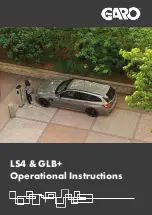
4-5. Use other driving system
155
4
Driv
in
g
CAUTIONS
If during ACC cruise control, when the vehicle is too close to the vehicle ahead (for example, due to
sudden emergency braking of the vehicle ahead), the system will send an audible and visual alarm to
the driver through the instrument cluster. At this time, the driver should pay attention to the distance
between vehicles and take over the vehicle control.
When the driver depresses the accelerator pedal to actively accelerate, the cruise speed icon
displayed on the multi-function screen of the instrument cluster will flash. This is a normal
phenomenon.
ACC may lose the target vehicle or misidentify the target vehicle when the vehicle enters or leaves a
curve, changes lanes or the vehicle ahead is stationary.
ACC cannot detect other sides other than the rear of the vehicle, children, pedestrians, animals or
other objects, and apply brakes for them, so you should drive carefully.
Due to the SACC's limited braking capacity, there may be no time to deaccelerate to avoid collision
with the preceding vehicle. This may happen when the preceding vehicle suddenly slows down, stops or
enters your lane. In case of danger, press the brake pedal for braking actively.
Focus all of your attention on driving and get ready to take actions and to apply the brakes.
The driver should adjust the following distance according to the traffic flow ahead and the current
weather conditions, such as rain and snow, and set up the ACC system reasonably. Whenever, you need
to ensure that your vehicle can be decelerated to standstill within your field of vision.
ACC can only identify motor vehicles (e.g. cars, trucks, etc.) with legal license plates and can run on
the highway. If the vehicle ahead is irregular in shape, have been modified and covered by spraying,
the identification effect cannot be guaranteed, and the identification of pedestrians and narrow
vehicles (e.g. bicycles, motorcycles, etc.) cannot be guaranteed. At this time, the driver should take over
the vehicle according to the actual situation.
ACC system may not be able to accurately identify large trailers. At this time, the driver should take
over the vehicle according to the actual situation.
ACC system cannot judge accurately the width of the front lane. Therefore, when the front lane in
the driving direction of the vehicle is too narrow and the driver feels unable to pass through it
normally, the ACC system should be deactivated immediately by braking and the vehicle should be
controlled by the driver.
Do not use adaptive cruise control on steep slopes. ACC may not detect the preceding vehicle in the
same lane on a long steep slope. You usually need to control the acceleration and braking of your
vehicle by yourself on a long steep slope. If the brakes are applied, ACC is canceled.
The preceding vehicle icon on the combination instrument will be displayed if the vehicle travelling
in the same direction on the same lane is detected. If the icon display does not match the actually
observed situation, you are responsible for controlling your vehicle and driving it based on the actual
situation.
If the foot is placed on the accelerator pedal, the adaptive cruise control may not apply the brake
automatically, thus causing a collision with the vehicle ahead, and the driver should pay attention.
Summary of Contents for HS5
Page 2: ......
Page 24: ...22 ...
Page 74: ...2 Instrument Cluster 72 ...
Page 378: ...8 2 Measures to Be Taken in Emergencies 376 ...
Page 379: ...377 9 Specifications Maintenance data 378 Fuel information 390 Vehicle specification 9 ...
Page 395: ...393 List of Abbreviations 394 Other information ...
















































